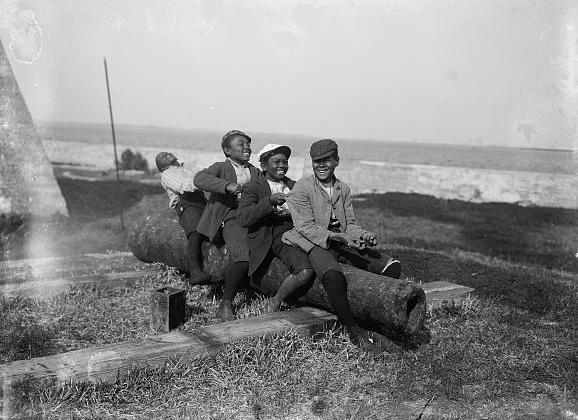
Artists and Photographers: William Henry Jackson (United States, 1843-1942)

Figure 1.-- Here four black boys sit on an old Spanish cannon, we think next to the Castillo de San Marcos, St. Augustine, Florida. Jackson took the photograph in 1902. After his Western sojourn !860s-80s), he alwats seems to have had a camera handy).Notice the boys wearing long stockings even in semi-tropical Florida. Negative: WHJ 110-02. Source: Detroit Publishing Co. No. 030806.
|
|
William Henry Jackson had a spectacular career encompassing painting, Civil War veteran, geological survey photographer and an explorer, and entrepreneur. He was also a great-great nephew of Samuel Wilson--the inspiration for America's national symbol Uncle Sam. William was born in Keeseville, New York (1843). This was just after photography was invented, but his first passion was for painting, excelling in water colours. He graduated from the Troy Female Academy (Emma Willard School). While still a teenager he had become a talented artist, in paet because of his mother's interests. He produced many wonderful images of pre-Civil-War America. Aftr brief service in the Civil War he headed west. He won a commission from the Union Pacific Railroad to document the scenery along the various railroad routes for promotional purposes (1969). Photography was a wonderful medium for this because so many more images could be photographed than painted. He thus became an importnt early Ametivan photographer. Jackson was a prodigy as a painter and never gave it up even as he was creating numerous important photograohic immages. He was especially famous for his paintings of the American West it in classic period after the Civil War. He was almost bankrupted by the Panic and Depression of 1893-95. He accepted a propisition offered by Marshall Field, the noted Chicago departmnent store owner, to go on a world tour with the purpose of photographing and gathering specimens for a huge new museum, planned for Chicago which had become the collosus on the Plains and unlike the big northeastern cities did not yet have the cultural amenities of a major city. Jackson's photograohs and written reports were published by Harper's Weekly magazine. He returned to Denver and entered the world of buiness and publishing. He sold his extensive stock of negatives and his own services to the Detroit Publishing Co. (1897). The company had just acquired the exclusive ownership and rights to the photochrom process in America. Jackson then joined the company as president (1898). - This was just as the Spanish American War broke out and created a huge interest in foreign countries and demand for the Detroit Publishing Company's images, primarily consusting of Jackson's archive. The Company produced images ranging from postcards to mammoth-plate panoramas. Jackson final major effort was painting murals of the Old West for the new U.S. Department of the Interior building in Washington, D.C. (1924). Late in life he was hired as a technical advisor for the filming of 'Gone with the Wind' (1939). He died just short of his 100th birthday (1942).
HBC

Navigate the Boys' Historical Clothing Web Site:
[Return to:Main photographer page]
[Introduction]
[Activities]
[Biographies]
[Chronology]
[Clothing styles]
[Countries]
[Bibliographies]
[Contributions]
[FAQs]
[Glossaries]
[Images]
[Links]
[Registration]
[Tools]
[Boys' Clothing Home]
Navigate the Boys' Historical Clothing Web Site:
[Sailor suits]
[Sailor hats]
[Buster Brown suits]
[Eton suits]
[Rompers]
[Tunics]
[Smocks]
[Pinafores]
[Lederhosen]
Created: 6:25 AM 7/4/2012
Last updated: 6:25 AM 7/4/2012



